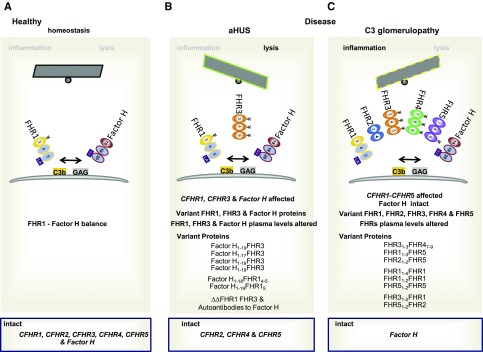Figure 6.
FHR mutant and hybrid proteins affect complement regulation at target sites. Gene mutations and copy number variations in the human Factor H–CFHR gene cluster in aHUS and C3 glomerulopathy affect protein structure and protein levels in plasma and influence the fate of complement control at target surfaces. (A) Normal homeotic scenario. FHR1 and Factor H with their homologous C-terminal regions bind to surface-deposited C3b at danger sites and to glycosaminoglycans (GAGs). The proteins are shown and the three C-terminal recognition region is presented, and the FHR1-specific LA and the Factor H–specific SV residues in the most C-terminal domains are shown. The balance of FHR1 and Factor H at modified target sites is influenced by the structure of the proteins; by Factor H, FHL1, and FHR plasma levels; by the binding intensities of the proteins to the ligands; and by the density of C3b and the type and composition of GAGs at sites of damage. FHR1 competes with Factor H for surface binding and, in a proper combination, the two regulators adjust and fine-tune local complement action. Thereby, FHR1 initiates inflammasome activation and Factor H dissociates the alternative pathway C3 convertase and inhibits complement progression. (B) Scenarios in aHUS and C3 glomerulopathy. aHUS scenario, left panel: Factor H::FHR3, Factor H::FHR1, and FHR1::Factor H hybrid proteins together with altered plasma levels influence the local FHR1, Factor H balance at a damage surface (left site). C3 glomerulopathy scenario, right panel: The various FHR hybrid and mutant proteins, many of which having two interacting segments and form large oligomeric complexes, influence the local FHR1, Factor H balance at damaged surfaces. Scenarios in aHUS, left panel: Various scenarios in the form of deletions; insertional mutations, including intragene; as well as chromosomal duplications generate CFHR–Factor H or Factor H–CFHR hybrid genes. In aHUS, Factor H and the CFHR1 and CFHR3 genes are affected, but CFHR4, CFHR2, and CFHR5 genes remain intact. Scenarios in C3 glomerulopathy, right panel: Various scenarios in the form of deletions; insertional mutations, including intragene; as well as chromosomal duplications generate CFHR-CFHR hybrid genes. In C3 glomerulopathy all five CFHR genes can be affected, but the Factor H gene remains intact.

